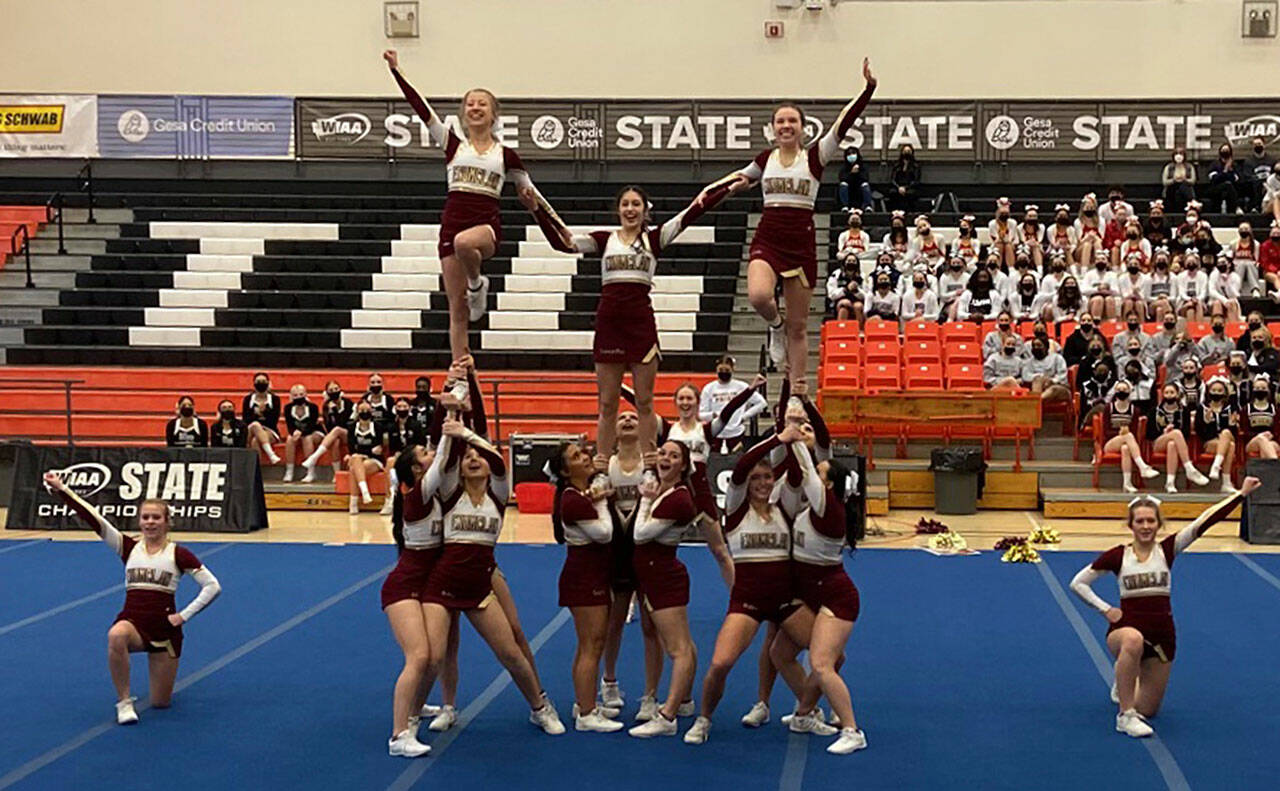Despite a chaotic season and opponents from much bigger schools, Enumclaw put on a clinic at the state cheerleading championships this month, taking home two first-place trophies from the Feb. 4 and 5 tournament.
“I couldn’t believe it,” cheer coach Kim Westerberg said in a recent interview. “I was shell-shocked when they announced us in one division. … When they announced us in the second, I don’t think I’ve ever been more proud of anything in my life.”
Earning the top rankings at state came on the heels of one of the worst qualifying event EHS has ever performed, said senior cheer captains Leah Lidke, Brook Faul, Lacey Bill, and Haley Chavis.
“Our last competition, everything fell. It was awful,” Faul said.
“Then we went to state, and we had the best routine we ever [had],” senior athlete Hailey Anderson added.
Typically, sport teams compete against schools of similar overall student populations. Titanic 4A schools duke it out against each other while medium-sized 2A schools like Enumclaw compete among themselves.
But not in many competitive cheer events, Westerberg explained: Different size schools often compete in similar divisions, broken down merely by how big their cheer teams are.
In both their divisions, Enumclaw went up against and defeated much larger, highly competitive schools like Skyline, Bothell and Curtis.
“These girls are talented, and I could not be prouder to be their coach,” said Westerberg, who is in her 19th year at Enumclaw.
Competitive cheer, as opposed to sideline cheering at other sporting events, is a WIAA sport that puts cheer teams head-to-head. The sport has only been around in Washington since 2005, and Enumclaw made their debut at the state competition in 2008.
The Enumclaw girls won their first title in the co-ed division in 2016. They took first in their division in 2020, but did not take home a trophy that year because they just barely didn’t score enough points. (Westerberg still considers it their second state title.)
This year, the girls’ team took first place in the Game Day Large division (20 athletes), scoring 92.8 points in a field of 2A, 3A and 4A-size schools. They also took first in the medium-sized Traditional division, scoring 88.5 points for their 15-girl tumbling routine — the highest scoring traditional tumbling routine across all divisions in the state.
The tumbling division is an intense, technical display of coordination, where athletes perform flips and handsprings across the mat.
“Game Day is more fun,” Westerberg said. “It’s a recreation of the cheering the team would do at the sidelines of a Friday night football game, fight song and all.”
Enumclaw’s cheer training starts at the end of August. Teams then competed at state qualifiers through the late fall and the winter to earn a spot at the state championship in Battle Ground.
Enumclaw’s team qualified their routines at a December competition, and attended another qualifier in early January for practice in front of judges.
That first qualifier, Bill said, when they officially qualified for state, was “decent,” but the second completely bombed.
“The entire routine just crumbled to the ground,” she added. “That was a disaster, and I think a lot of us lost hope after that. But we pushed through, and we won state, and I think that’s just awesome.”
“They got, I think, the lowest score in the qualifier,” Westerberg said. “That’s what we call ‘going zero to hero.’”
There were myriad reasons the team performed so poorly during the qualifier event.
“There were a lot of ups and downs — injuries that we had to overcome, and some that weren’t fully overcome and had to go into state like that,” senior athlete Magi Galan said. “It was really hard to practice, because even if there’s just one [person] gone, there was a lot of things that couldn’t go — a lot of things you’d have to hold to the next practice when they came back.”
COVID-19 reared its ugly head during the winter, too. Students continuously came down the the virus one or two at a time, which kept the team from practicing as a whole for a month or two.
“We had to scratch from every qualifier in January,” Westerberg said. “It was horrible. And then we all got healthy, got back together toward the end of the month and worked really hard to get ready for Feb. 5.”
Courier-Herald editor Ray Miller-Still contributed to this report.



